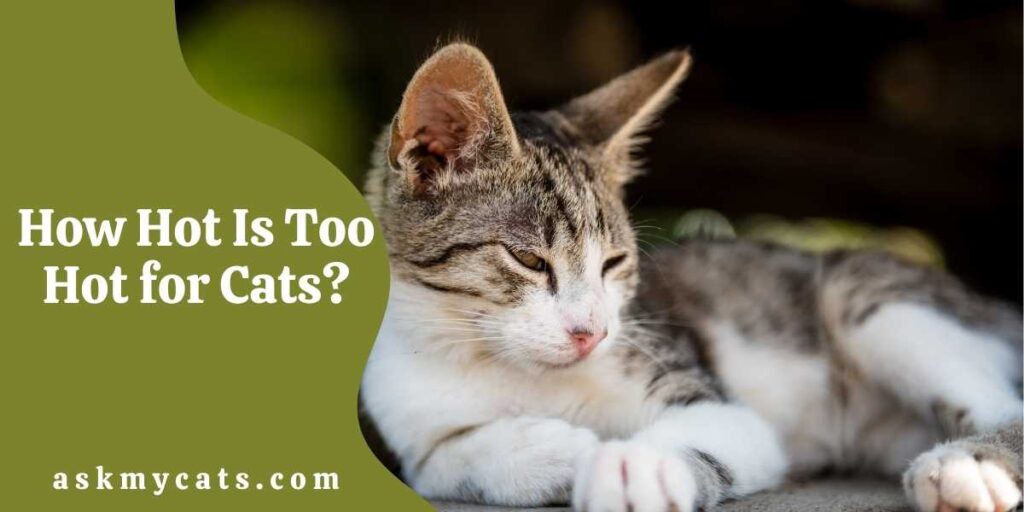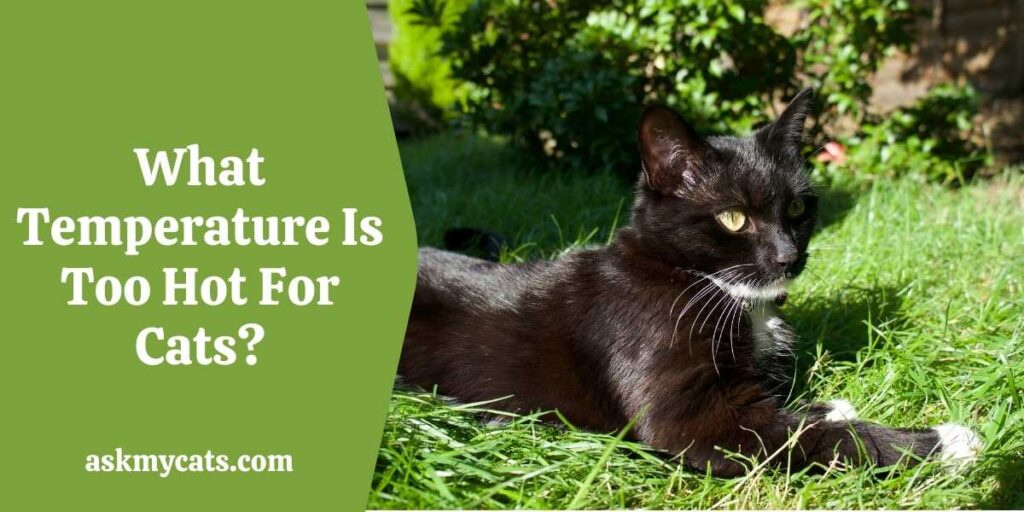When the temperature outside drops below 45°F (7°C), a cat’s thick fur and layers of body fat keep her warm while protecting her from cold-weather ailments like hypothermia and frostbite.
On the other hand, a cat’s physique can endure cooler temperatures considerably better than it can handle the heat and humidity of summer.
Cats cannot tolerate temperatures above 104°F (40°C). Heatstroke can occur when a cat’s body temperature rises beyond 104°F (40°C), and cats with long hair and short snouts struggle significantly more in hot weather.
In cats, having access to shade, cool water, and ventilation can help to mitigate the effects of extreme heat.


Give Your Cat the Perfect Day
Get the Free Ebook!
What Temperature Is Too Hot For Cats?
Temperature exceeding 104 degrees Fahrenheit is too hot for cats.

100 to 102.5 degrees Fahrenheit is the optimal body temperature for cats. For longhaired cats, a slight increase in temperature is tolerated. More body heat is generated by having more hair.
Hyperthermia is caused by a temperature of 104°F or above (heatstroke). Before your cat reaches this point, assist it in cooling off.
Because cats are natural sun worshipers, keep an eye on your cat during the summer. Many cats will jump at the chance to get some sun. It’s acceptable for a cat to spend some time in the sun, but know when he’s getting too hot.
Cats are calmer when warm since they have a greater body temperature than humans. Wherever feasible, cats will modify their body postures to keep warm.
This necessitates temperature management, particularly in the summer, since cats might overheat if the situation is not carefully regulated.
A body temperature of 100 – 102.5 degrees Fahrenheit is ideal for cats. The temperature of a cat varies. According to Science, a cat cools down when resting and regulates body temperature via eating.
Cats enjoy the sun and find it calming in warmer climates. This means a cat can overheat and not realize it until it’s too late. If your cat sleeps in direct sunlight, it might be endangering its health.
The temperature of the environment is crucial to a cat’s comfort. Cats cannot shed their fur in the same manner that other animals do.
You must keep the air surrounding your cat from becoming too hot and stuffy.
In lower temperature conditions, longhaired cats thrive, particularly Siberians, Norwegian Forest Cats, Persians, Ragdolls, and Maine Coons. They stay warm thanks to their long, thick coats.
Even if they shed in the heat, these breeds will be inherently warmer than their shorthaired relatives.
In chilly areas, shorthaired cats have a harder time staying warm. This implies they will be able to enjoy a warmer environment. These cats will also spend more time in the sun during the summer. They are, however, both at risk of overheating.
A safe temperature for a cat is between 75 and 78 degrees Fahrenheit in the indoor environment. Longhaired breeds prefer the lower end of the range. Cats who are older or have short hair will tolerate somewhat warmer air.
However, you should not rely on the thermostat to keep a cat safe. You’ll also need to keep an eye on things. Keep an eye on your cat to make sure it isn’t overheated. If your cat becomes too hot, it will begin to act strangely.
Must Read: 5 Simple Ways to Keep Your Indoor Cat Cool During Summer
Can Cats Handle Hot Weather?
Cats cannot handle too hot weather.

At any time of year, cats can become overheated. A cat’s body temperature can rise beyond 100 degrees Fahrenheit after prolonged exposure.
Cats are more likely to overheat during the warmer months. When a fur coat is worn in hot weather, it can cause an increase in body temperature.
A cat’s body will be stressed just from panting. This behavior puts a burden on the feline respiratory tract. This should be avoided at all costs, especially in senior cats.
Assist your cat in cooling down and lowering its body temperature at this stage. Any medical difficulties will be avoided as a result of this. If the cat continues to overheat, it will dehydrate, and hyperthermia will develop.
Also, check out do cats like air conditioning
Does Hot Weather Bother Cats?
Yes, hot weather will be problematic for cats.

The typical cat’s internal body temperature is just slightly higher than that of humans, at 101°F-102.5°F (38°C-39°C). While you can crank up the air conditioning in the summer or layer up in the winter, your cat only has her coat and body fat to keep her warm.
Outdoor temperatures between 45°F and 90°F (7°C and 32°C) are typically safe for cats, and they are less likely to leave their optimal body temperature range.
In other words, in near-optimal settings, 45-90°F (7°C-32°C) is ideal for cats. The mid-70s could be more comfortable for your cat if it’s humid and there’s no wind during the day.
How Hot Is Too Hot for Cats Indoors?
Most indoor cats will suffer from heatstroke if temperatures rise beyond 105 degrees Fahrenheit (hyperthermia).
It is possible that if the body temperature is not brought down immediately, major organ damage or even death will occur. The typical body temperature of a short-haired cat is around 100 degrees Fahrenheit. Because of their coats, long-haired animals have a greater body temperature.
Warmth attracts cats, who like to sleep in the sun. On the other hand, Cats do not withstand extreme heat any better than humans.
This is why temperature control is crucial. We must offer a cool, shaded area with access to clean drinking water for cats because they cannot cool themselves as effectively as people.
How Can I Tell If My Cat Is Too Hot?
Your cat will be panting excessively if he is too hot.
Putting your cat in a cooler place in the house (like the garage or basement) and giving her a dish of cold water might help her chill down.
If left untreated, your cat’s symptoms will increase as he approaches heatstroke, which is defined as a dangerously high internal body temperature of at least 105°F (41°C).
Your cat may vomit, have dark red gums, or have difficulty walking at this point. If you want to avoid serious organ damage or death, you’ll need to see a veterinarian right away.
The following signs demonstrate that your cat may be too hot and require immediate cooling:
- Panting (the first clear indicator that something is wrong)
- Restless behavior
- Drooling
- Non-stop grooming
Can Cats Overheat In Hot Weather?
Cats can overheat in hot weather.
When you’re warm or even hot, your cat will likely feel the same way. Our feline companions, like us, are vulnerable to overheating, heatstroke, dehydration, and other heat-related ailments. Cats are more susceptible to heatstroke and hyperthermia on hot, humid, or very warm days.
Although cats take the heat better than dogs (after all, they are known for seeking out sunny locations for sunbathing), they can nevertheless suffer from overheating (hyperthermia) and heatstroke. Cats are also quite adept at maintaining their calm.
Can Cats Die Due To Hot Weather?
Cats can die as a result of hot weather.
Heatstroke can occur when a cat’s internal body temperature rises above 104 degrees. This causes harm to the body’s organs and cells, which can swiftly lead to death.
Heatstroke is a serious medical condition. If you feel your cat is overheating, call a veterinarian right away.
Frequently Asked Questions
What happens if a cat gets too hot?
Heatstroke, also known as hyperthermia, is a life-threatening disease in which a cat’s internal organs shut down due to an increased body temperature. The cat will experience heat fatigue at first as the temperature rises, escalating to heatstroke.
How long does it take for a cat to die from heat?
The most prevalent cause of heatstroke is being confined in a hot and enclosed place. Heatstroke may be avoided by never leaving your cat in such locations. A cat can die from a heat-related disease in as little as 15 minutes.
Do cats need AC?
Since cats are smaller than humans and have different temperature regulations than humans, we should keep in mind that they may want something different than we do. Cats, on the whole, can handle higher temperatures than humans.
Final Words
Cats have a body temperature that ranges from 100°F to 102.5°F on average. They can’t always self-regulate when there’s too much heat. Hyperthermia is defined as a temperature higher than normal, and a temperature greater than 105°F can result in heatstroke.
Ask your questions in the comments section below.
